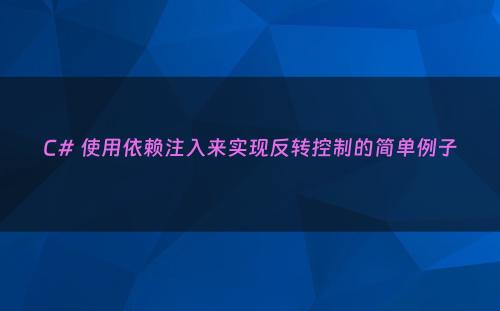网站首页 > 基础教程 正文
在C#中,反转控制(Inversion of Control,IoC)和依赖注入(Dependency Injection,DI)是常用的软件设计模式,用于实现松耦合和可测试性。
下面是一个简单的示例,展示了如何使用依赖注入来实现反转控制:

// 定义一个接口
public interface IMessageService
{
void SendMessage(string message);
}
// 实现接口的具体类
public class EmailService : IMessageService
{
public void SendMessage(string message)
{
Console.WriteLine("Sending email: " + message);
}
}
// 使用依赖注入的类
public class NotificationService
{
private readonly IMessageService _messageService;
// 通过构造函数注入依赖
public NotificationService(IMessageService messageService)
{
_messageService = messageService;
}
public void SendNotification(string message)
{
_messageService.SendMessage(message);
}
}
// 在应用程序中使用依赖注入
public class Program
{
public static void Main()
{
// 创建依赖实例
IMessageService messageService = new EmailService();
// 将依赖注入到需要的类中
NotificationService notificationService = new NotificationService(messageService);
// 使用依赖注入的类
notificationService.SendNotification("Hello, world!");
}
}
在上面的示例中,定义了一个IMessageService接口,并实现了一个EmailService类来发送电子邮件。
然后,创建了一个NotificationService类,它依赖于IMessageService接口。通过在构造函数中接收IMessageService实例,实现了依赖注入。
最后,在应用程序的入口点,创建了一个EmailService实例,并将其注入到NotificationService中,然后调用SendNotification方法。
通过使用依赖注入,可以轻松地替换具体的依赖实现,以满足不同的需求或进行单元测试。这种松耦合的设计有助于提高代码的可维护性和可测试性。
猜你喜欢
- 2024-12-02 C++中的struct完全可以被class替代,为什么不删去它呢?
- 2024-12-02 C#笔记~泛型
- 2024-12-02 C# 中 IsNullOrEmpty 和 IsNullOrWhiteSpace 你用对了吗?
- 2024-12-02 C#面试宝典 2022年 60个常见的C#面试问题和答案
- 2024-12-02 C#学习随笔—操作BIN文件(读,写,替代)
- 2024-12-02 C# 入门深度学习:万字长文讲解微积分和梯度下降
- 2024-12-02 344.C# 中的正则表达式:字符匹配、字面字符、特殊字符和转义序列
- 2024-12-02 C#通过二进制读写实现文件的伪加密
- 2024-12-02 C#移除字符串中的不可见Unicode字符
- 2024-12-02 使用 C# 解析月份简写的时间日期格式
- 最近发表
- 标签列表
-
- gitpush (61)
- pythonif (68)
- location.href (57)
- tail-f (57)
- pythonifelse (59)
- deletesql (62)
- c++模板 (62)
- css3动画 (57)
- c#event (59)
- linuxgzip (68)
- 字符串连接 (73)
- nginx配置文件详解 (61)
- html标签 (69)
- c++初始化列表 (64)
- exec命令 (59)
- canvasfilltext (58)
- mysqlinnodbmyisam区别 (63)
- arraylistadd (66)
- node教程 (59)
- console.table (62)
- c++time_t (58)
- phpcookie (58)
- mysqldatesub函数 (63)
- window10java环境变量设置 (66)
- c++虚函数和纯虚函数的区别 (66)
